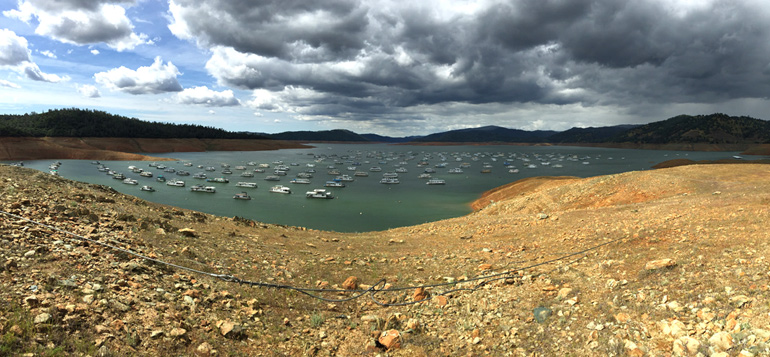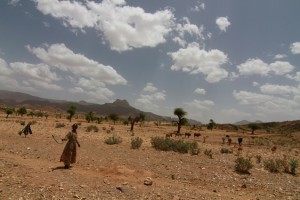The Drought-Climate Connection
Few challenges today are more global than climate change. Human activities, including the burning of fossil fuels and the destruction of forests, have raised atmospheric carbon dioxide concentrations to levels not seen in the history of human civilization. Communities are feeling the impact as increasing temperatures raise sea level and exacerbate drying that has led to droughts and conditions ripe for forest fires.
Not all warming and drying is anthropogenic, but the changes we see today are happening far faster than natural climate variability alone can account for. To gauge the human role requires a broad understanding of the many influences on global climate.
Lamont scientists across the disciplines have been building knowledge of climate and natural variability for over 65 years from evidence analyzed in deep sea sediment cores collected during half a century of research cruises, cores from ice sheets and corals, chemical changes in the oceans and Earth, and tree ring cores from around the world that have been used to build a growing series of drought atlases mapping wetness and dryness over millennia.
The California Drought
For the first time, scientists this summer were able to use that growing knowledge base to quantify the role that human-induced warming played in the four-year California drought.
Park Williams and colleagues explained that rising temperatures appeared to be making conditions worse in California by driving moisture from plants and soil into the air, worsening the drought by as much as a quarter. The findings suggest that within a few decades, continually increasing temperatures and resulting moisture losses would push California into even more persistent aridity.
“A lot of people think that the amount of rain that falls out of the sky is the only thing that matters,” said Williams, a bioclimatologist at Lamont. “But warming changes the baseline amount of water that’s available to us, because it sends water back into the sky.”
“As time goes on, precipitation will be less able to make up for the intensified warmth,” he said.

California’s Lake Oroville in 2015 (Ray Bouknight/CC-BY-2.0)
The researchers analyzed multiple sets of month-by-month data from 1901 to 2014. They looked at precipitation, temperature, humidity, wind, and other factors. They could find no long-term rainfall trend. But average temperatures have been creeping up—about 2.5° Fahrenheit over the 114-year period, in step with building fossil-fuel emissions. Natural weather variations have made California unusually hot over the last several years; added to this heat was the background trend. When rainfall declined in 2012, the air sucked already scant moisture from soil, trees, and crops.
Because of the complexity of the data, the scientists put a range on the proportion of the drought caused by global warming. The paper estimates 8 to 27 percent, but Williams said that somewhere in the middle—probably 15 to 20 percent—is most likely. The study suggests that by around the 2060s, more or less permanent drought will settle on the region, interrupted only by the rainiest years.
A Global Challenge
Evidence that the planet has been warming is being documented around the world. During 2015, dendrochronologist Nicole Davi and colleagues published a study using tree rings dating back more than 1,000 years in Mongolia that confirms recent warming in central Asia has no parallel in any known record. Peter deMenocal co-authored a paper reporting analyses of leaf wax in a sediment core from off the Somalia coast that indicated the Horn of Africa has become progressively drier over the past century and is drying at a rate that is both unusual in the context of the past 2,000 years and in step with human-influenced warming. DeMenocal’s study also projects that the drying will continue as the already geopolitically unstable region warms.

Studies show drying in the Horn of Africa is in step with global warming. (Brian Kahn/IRI)
Another study, led by Benjamin Cook and co-authored by Jason Smerdon, used evidence of North America’s drought history and measures of soil moisture, precipitation, evaporation, and transpiration, along with climate models, to project conditions in the future. They found that during the second half of this century, the U.S. Southwest and Great Plains will face persistent drought worse than anything seen in at least 1,000 years, with drying driven primarily by human activities. The effects of carbon dioxide on higher average temperature and subsequent drying emerged as a strong signal across several different climate models that they applied.
“Even when selecting for the worst megadrought-dominated period, the 21st century projections make the megadroughts seem like quaint walks through the Garden of Eden,” Smerdon said.
A subsequent paper published by post-doctoral research scientists Justin Mankin highlighted 32 snow-dependent basins worldwide with large populations most at risk of declining meltwater, including northern and central California, the Colorado and Rio Grande rivers, the Atlas basin in Morocco, basins in Europe feeding Spain, southern France, the Balkans and Caucasus, and northern Turkey, and the Zagros Mountains in the Middle East.
The Center for Climate and Life
In many regions of the world, particularly arid environments such as the Middle East and Africa, droughts already threaten food and water security. In 2015, Columbia University established the Center for Climate and Life at Lamont to bring researchers from across the university together for collaborative work focused on climate’s impact on life’s essentials – food, water and shelter, and sustainable energy – and to work with business leaders to turn that knowledge into solutions.
“Climate is changing faster than our ability to keep pace,” said deMenocal, the center’s founding director. “At a time of decreasing federal support for this basic research, we will mobilize our considerable talent to generate the knowledge we need, and to put it to use in the marketplace.”